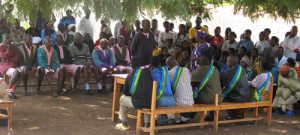This post was written with Lindsay Heger, who is Associate Director, One Earth Future Foundation.
We’ve seen the rise of judicial means to bring human rights violators to trial in recent decades, both regionally and globally. Most famously, the International Criminal Court, was established after the Rome Treaty was ratified in 2002 in order to bring the most egregious state violators of human rights to to account for crimes of genocide, crimes against humanity, and war crimes (though this court has not been without its controversies, most acute of which is that the court deliberately over-targets African leaders). There are also many arguments about the effect of the ICC, including the effects that having such an institution has on individual lawyers, judges, and other officials in the practice of law. The complementarity clause of the ICC, furthermore, might be spurring domestic legal institutions to change in anticipation of possible prosecution by the Court, creating a race to the top in terms of complying with the prosecution of war crimes in order to avoid facing the ICC.
In addition to a decades-long effort to establish an effective international court system, there are also hybrid courts (perhaps the most well-known is the one set up in Sierra Leone) that blend international and domestic elements – currently, for example, the South Sudanese have appealed to the African Union to create such a court to address criminal accountability associated with the ongoing civil conflict. In fact, trials have become more common domestically as well, the most well-known example being the gacaca courts in Rwanda following the genocide. Designed to try the lesser crimes tied to the genocide, gacaca courts have toed the line between local traditions and trial-based justice in the process of creating a new socio-legal framework to deal with human rights crimes, to somewhat mixed results (see here and here).
All of this begs a question: why have trials such a prevalent way to deal with wartime crime? After all, in the transitional justice literature, much is made about the important of truth and reconciliation (TNR) as an alternative to the retributiveness of using courts. The most famous TNR, South Africa, while imperfect, remains a model for how these trial alternatives ought to be done. The deliberation over which of these options, TNR or trial, is “better” is an ongoing project, with steadfast opinions on both sides. Other methods include exile of abusive or ousted leaders, payment of reparations to victims, or reforming policing and courts systems. None of these options (except for exile, presumably) is cheap or easy. So when do governments choose one option (or a combination of options) over others?
Cast in this light, trials are not simply an internationally imposed outcome, but a political choice taken in light of various pressures from external actors, to be sure, but also internal considerations. Some of our research addresses the question of under what conditions post-conflict should we expect “the winning party” (i.e. now, the government) to try “the losers” (i.e. their former opponents)? More specifically, we are interested in the structural characteristics of these opponents that make them more or less likely to be pursued in courts after they lose.
Given our previous collaboration (with Danielle Jung) that explores the structure of terrorist organizations and the effect of their structures on lethality, we had a sense that centralization of groups matters for their abilities to wreak havoc from a governance perspective, but then also logically, how governors attempt to deal with them as effectively as possible. Our hunch is that, while a general sense of the strength of the losers (when they were still fighting) matters, what really matters is how the losers were structured. Centralized oppositions can mount more effective resistance both in terms of lethality, but also in terms of giving and receiving orders; centralized commands have a higher expectation that their strategies will be followed all the way down the chain. In battle, this helps centralized groups fight more consistently. In peacetime, centralization can help losers create more governance costs for winners. Governance costs, in this case, mean the likelihood (or ability) of a losing group to remobilize and restart the fight. In addition to being in conflict again, the implication of the remobilization of the losers signals the inability of the winners to consolidate their controls. In terms of costs, it means that winners are incapable of paying the governance costs sufficient to maintain peace, and the longer they allow centralized losers to float out there post-conflict, the more likely governments are 1) to face a remobilization and/or 2) pay increasingly high governance costs to keep the arrangement together.
As such, we argue that winners are more likely to use trials against centralized losers, that is, losers that were more vertically-organized during the conflict, because of their organizational structure. This runs counter some of the findings in the transitional justice literature that weaker losers are tried more, but also intuition – isn’t trying centralized losers “harder”? In addition to the fact that centralized losers can impose higher governance costs, they are also easier targets for trials compared to flat networks of disassociated rebels. As rebel groups may be increasingly professionalizing with time, a trend some notorious groups today do admittedly buck, when conflicts come to an end, those groups where centralized structures enable easier identification of culpable actors are good targets for trials. Thus we see two reasons why trials may be an attractive option for post-conflict governments. First, trials may be the most effective way to put the nail in the coffin of a centralized loser who may be capable of imposing high governance costs, perhaps even renewing the conflict. Second, centralization lowers the costs of trials as it makes responsible parties easier to identify.
In short, trials are political and strategic. And while we tend to think of them as serving justice and punishment, we also must be mindful of how losers continue to shape the policies of winners post-conflict.
Wendy Wong is an Associate Professor at the Department of Political Science at the University of Toronto and Director of the Trudeau Center for Peace, Conflict, and Justice at the Munk School of Global Affairs. Her research focuses on the study of NGOs and the importance of the variations between NGOs and the role of foundations in human rights.



Indeed, trials are strategic and political, I don’t think you would find many in the transitional justice field who would say otherwise! Trials are but one mechanism of many in a menu of options post-authoritarian and post-conflict states can pursue, and there has been a wealth of empirical analysis into why states make the choices that they make (see the Transitional Justice Data Base Project, Post Conflict Justice Dataset, Transitional Justice Research Collaborative, various works by Sikkink, Kim, and Dancy, etc.). Almost certainly there are multiple factors driving trials, and important variations among cases. I’m intrigued by your idea that organizational structures might also play a role in this, and look forward to seeing any evidence you find as you continue your work on this. The argument reminds me a bit of Monika Nalepa’s work on lustration laws (why former communists in East Central Europe decide to lustrate themselves!), and you should definitely check it out if you haven’t already. Good luck with this.
Thanks for the response! We’ve got a paper in the works that draws on many of the pieces and/or datasets you refer to here, but as far as we know, we’re the ones making the link directly to post-conflict contexts and trying to think about characteristics of the losing groups as a reason for the choice for trials. We’ll definitely check out the work on lustration laws too.